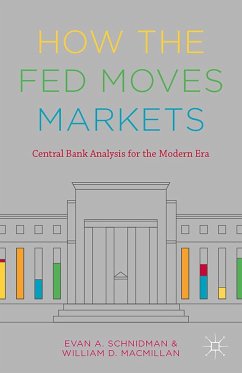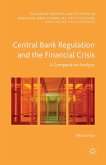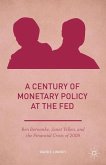Central banks have a profound impact on financial markets, and investors struggle to keep informed about their complex policy decisions. Technological and financial developments have transformed the US Federal Reserve Bank from a financial black box into a vocal, increasingly transparent institution-and the result is such a wealth of textual data that clues to future policy decisions may be lost among the details.
This book presents a solution to this problem by keeping track of those details. Schnidman and MacMillan demonstrate how the latest advances in automated text analysis, combined with the precision of domain expertise, are the keys to understanding how central banks move markets with their words. The authors outline a method to not only examine every piece of every central bank communication, but to do it in a way that is completely comprehensive and unbiased while quickly yielding hard, quantitative data that can be put to work in modern financial models.
This book presents a solution to this problem by keeping track of those details. Schnidman and MacMillan demonstrate how the latest advances in automated text analysis, combined with the precision of domain expertise, are the keys to understanding how central banks move markets with their words. The authors outline a method to not only examine every piece of every central bank communication, but to do it in a way that is completely comprehensive and unbiased while quickly yielding hard, quantitative data that can be put to work in modern financial models.
Few institutions are subject to such extreme and unrelenting scrutiny as the US Federal Reserve
System and yet there are a very limited number of texts that provide a clear and coherent
framework to aid in the systematic analysis of the policies of this remarkable institution. The
proposed text by Evan Schnidman holds the promise to fill this role and, thus, address what is
potentially a very broad academic and professional readership.
More specifically, his method-what he terms 'automated content analysis'-addresses the
limitations of current practices of 'Fed watching' while delineating a potentially innovative
means to assess the central bank's intentions and, thus, future policy actions.
The author is well qualified and well positioned to write an outstanding book, a book that I
would be excited to read and assign to my students.
The proposal is a very well conceived addressing an extremely timely series of issues on the
history and current practices of the Federal Reserve System. It is tightly argued and historically
grounded establishing the foundation for the decisive contribution of the text: an assessment of
central bank communication practices and systematic methods to evaluate them. As he puts it:
These new methods are then explored with a particular emphasis on how automated
content analysis of Fed communications can generate quantitative data about
communications that provides strong indications of future monetary policy. When
coupled with commonly used financial back-testing data, these policy projections can
even generate predictions for likely market response. This new method of systematically
analyzing central bank communications, along with providing evidence of weakness in
commonly used qualitative Fed watching methods, is the most significant contribution of
the book.
The author seeks to demonstrate how specific episodes in the history of central banking in the
US, particularly during the period 1946-5 illuminate the process of Fed modernization: its
institutional centralization, its growing reliance on technocratic practices, and ultimately its
commitment to rigorous communications. Much of this transformation revolves around central
bank commitments to 'transparency.' This prosaic and overused term, however, masks a
fundamental shift not merely in the practices of the Fed, but in the communicative dynamics of
finance more broadly. This is the unusual potential of the proposed project to address
reciprocally how the revolution in central banking mirrors decisive transformations in the
operation of financial markets and banking institutions.
Though it is not broached in the proposal, the work will, no doubt, provide a framework for
examining the operation of central banks globally. For example, the methods the author is
developing could be, with some modification, employed to examine comparatively the
communicative practices of virtually all the central banks that I have studied in Europe, Asia,
and Austral-Asia.
In sum, though the Fed is the subject of unrelenting scrutiny, there are few (if any) texts that
provide a coherent framework to aid in understanding the communicative policies and practices
of this extraordinary institution. The proposed text seeks to delineate innovative methods that can
fill this need and, thereby, address what is potentially a very broad readership. The author is well
qualified to write an exceptional book.
I strongly recommend that you pursue the proposed book project, 'How the Fed Moves
Markets.' Indeed, I would be very pleased to review the entire manuscript.
System and yet there are a very limited number of texts that provide a clear and coherent
framework to aid in the systematic analysis of the policies of this remarkable institution. The
proposed text by Evan Schnidman holds the promise to fill this role and, thus, address what is
potentially a very broad academic and professional readership.
More specifically, his method-what he terms 'automated content analysis'-addresses the
limitations of current practices of 'Fed watching' while delineating a potentially innovative
means to assess the central bank's intentions and, thus, future policy actions.
The author is well qualified and well positioned to write an outstanding book, a book that I
would be excited to read and assign to my students.
The proposal is a very well conceived addressing an extremely timely series of issues on the
history and current practices of the Federal Reserve System. It is tightly argued and historically
grounded establishing the foundation for the decisive contribution of the text: an assessment of
central bank communication practices and systematic methods to evaluate them. As he puts it:
These new methods are then explored with a particular emphasis on how automated
content analysis of Fed communications can generate quantitative data about
communications that provides strong indications of future monetary policy. When
coupled with commonly used financial back-testing data, these policy projections can
even generate predictions for likely market response. This new method of systematically
analyzing central bank communications, along with providing evidence of weakness in
commonly used qualitative Fed watching methods, is the most significant contribution of
the book.
The author seeks to demonstrate how specific episodes in the history of central banking in the
US, particularly during the period 1946-5 illuminate the process of Fed modernization: its
institutional centralization, its growing reliance on technocratic practices, and ultimately its
commitment to rigorous communications. Much of this transformation revolves around central
bank commitments to 'transparency.' This prosaic and overused term, however, masks a
fundamental shift not merely in the practices of the Fed, but in the communicative dynamics of
finance more broadly. This is the unusual potential of the proposed project to address
reciprocally how the revolution in central banking mirrors decisive transformations in the
operation of financial markets and banking institutions.
Though it is not broached in the proposal, the work will, no doubt, provide a framework for
examining the operation of central banks globally. For example, the methods the author is
developing could be, with some modification, employed to examine comparatively the
communicative practices of virtually all the central banks that I have studied in Europe, Asia,
and Austral-Asia.
In sum, though the Fed is the subject of unrelenting scrutiny, there are few (if any) texts that
provide a coherent framework to aid in understanding the communicative policies and practices
of this extraordinary institution. The proposed text seeks to delineate innovative methods that can
fill this need and, thereby, address what is potentially a very broad readership. The author is well
qualified to write an exceptional book.
I strongly recommend that you pursue the proposed book project, 'How the Fed Moves
Markets.' Indeed, I would be very pleased to review the entire manuscript.








